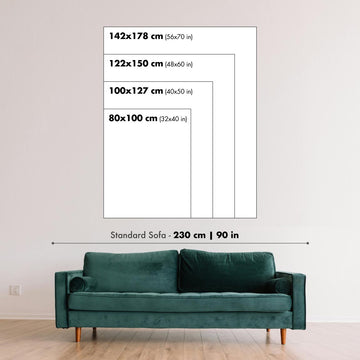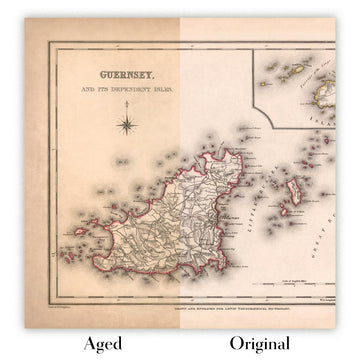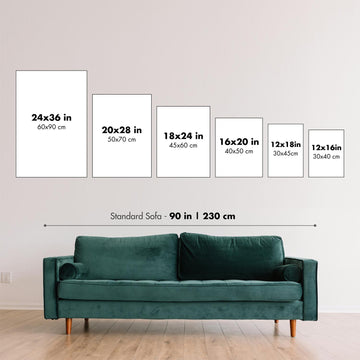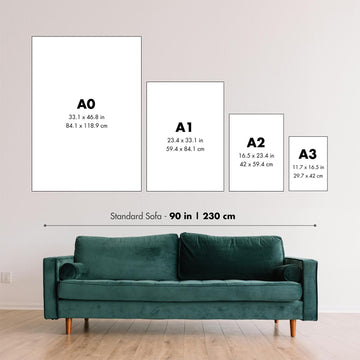



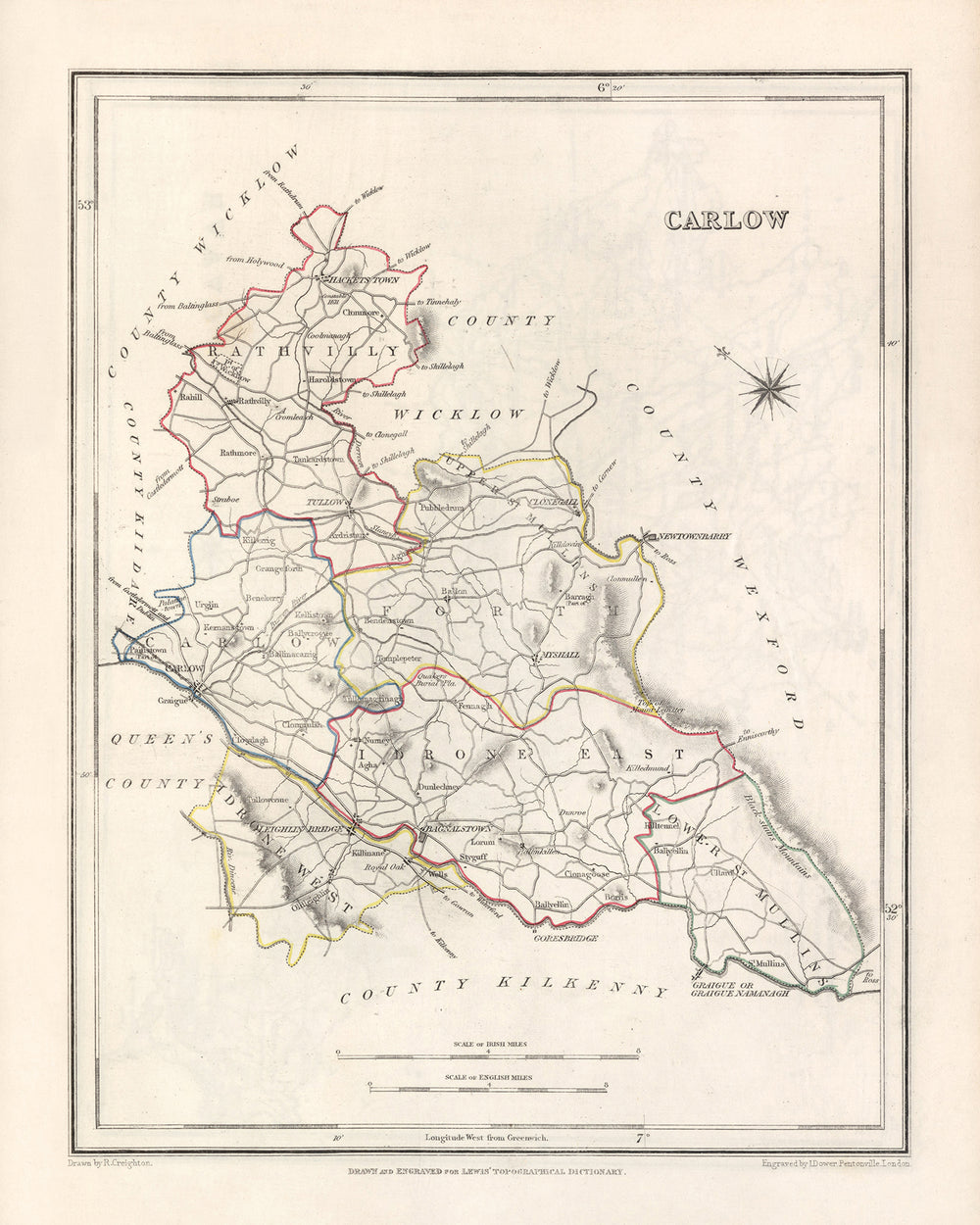

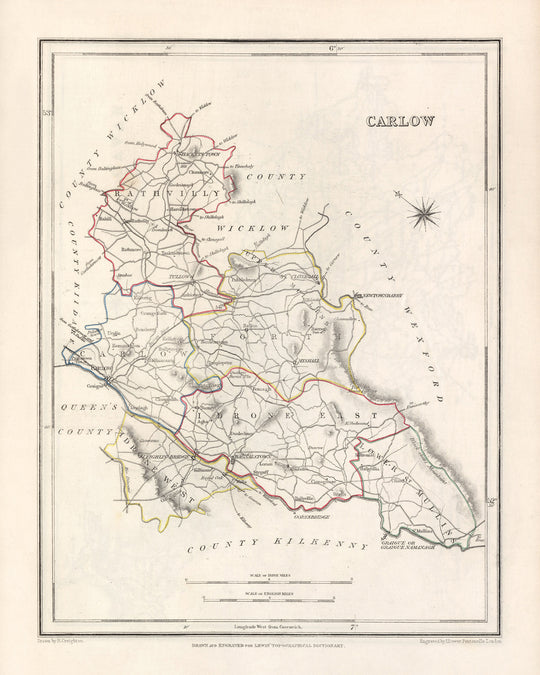








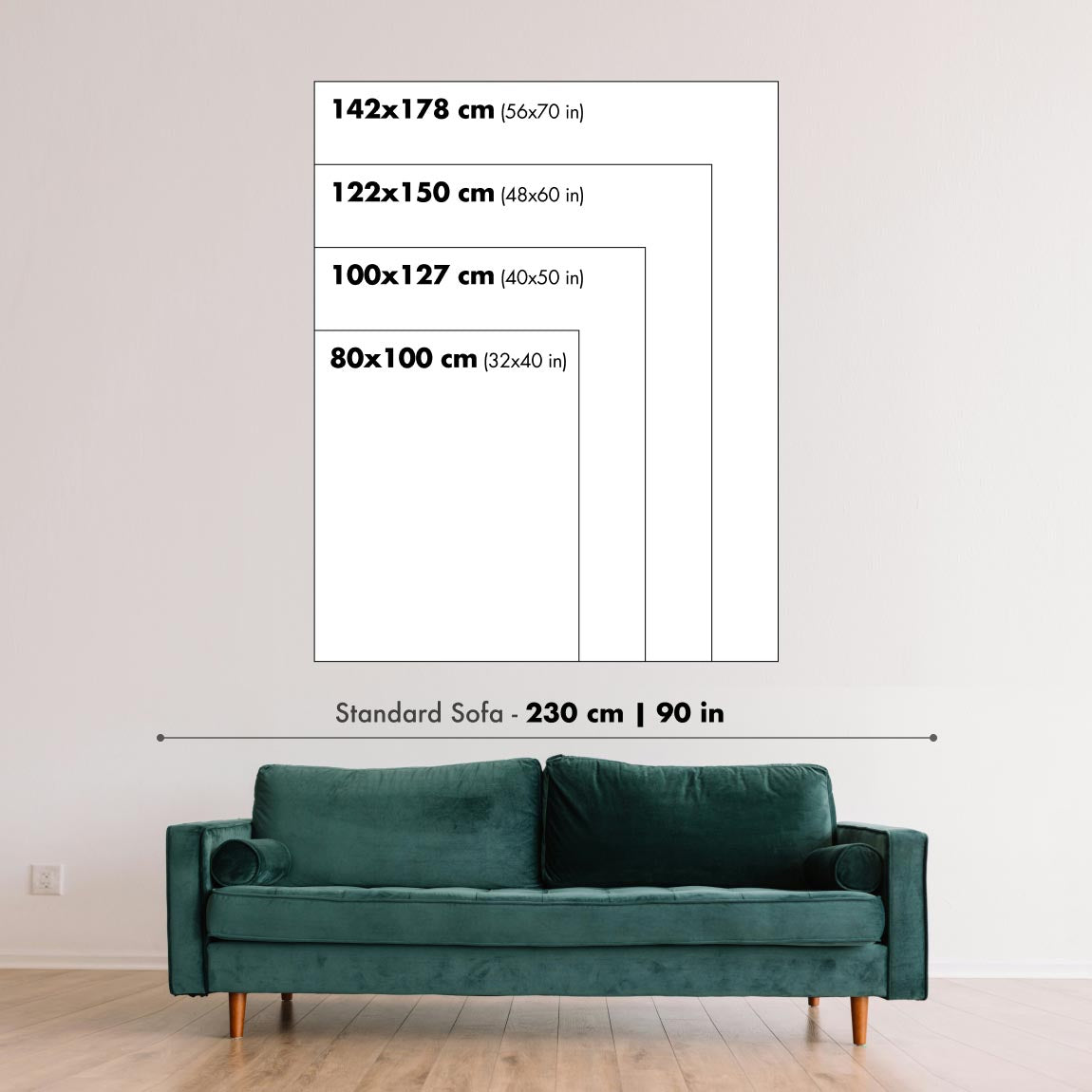
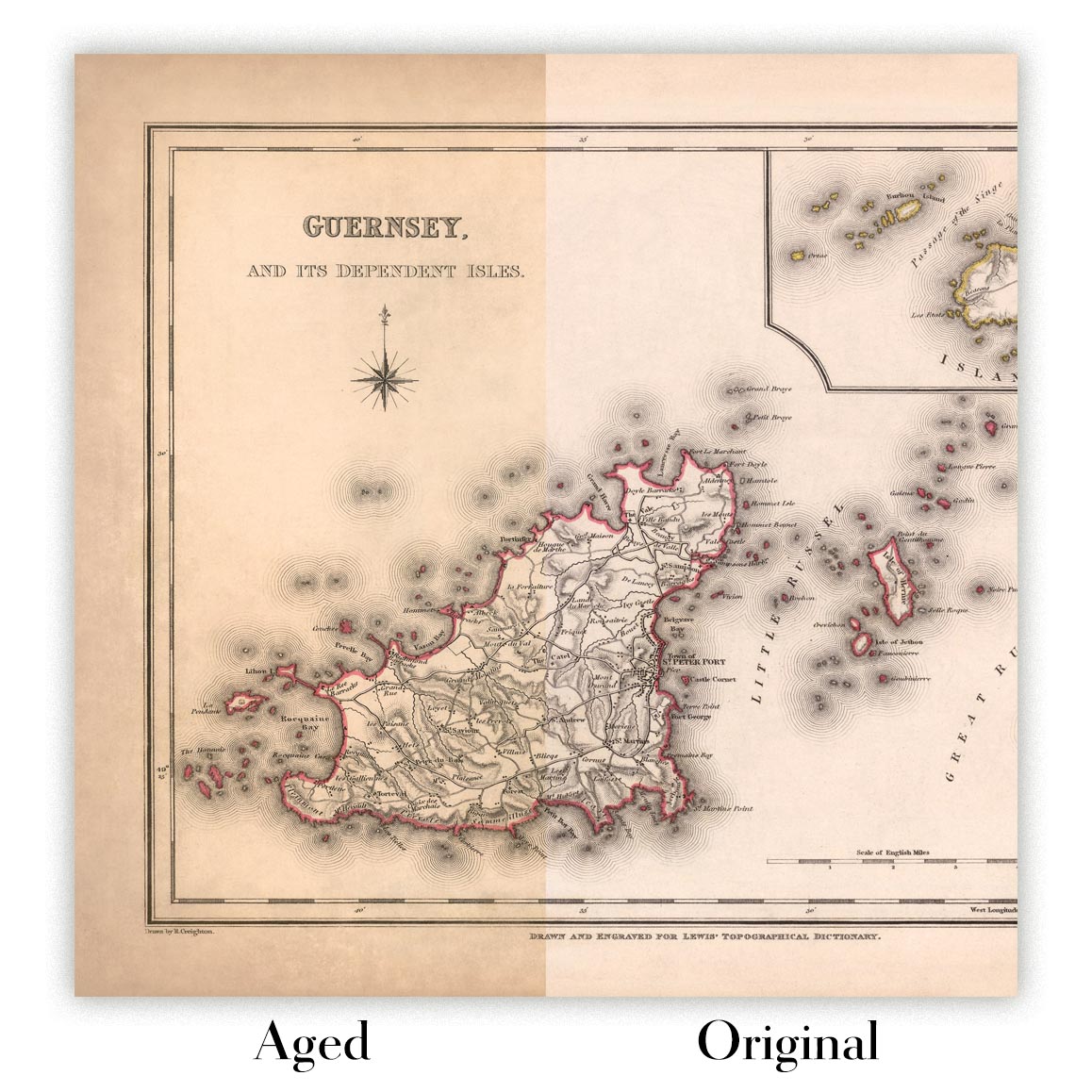



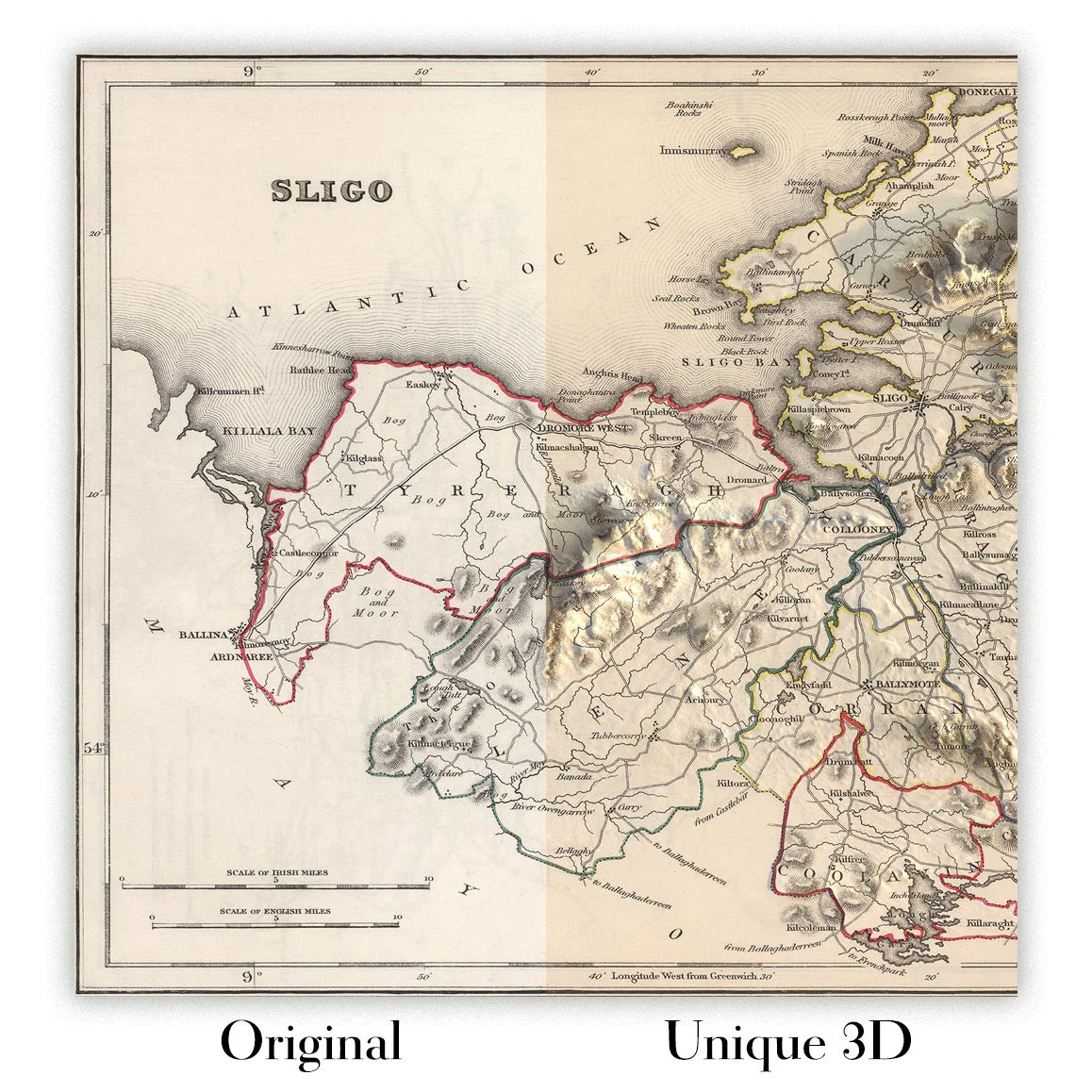
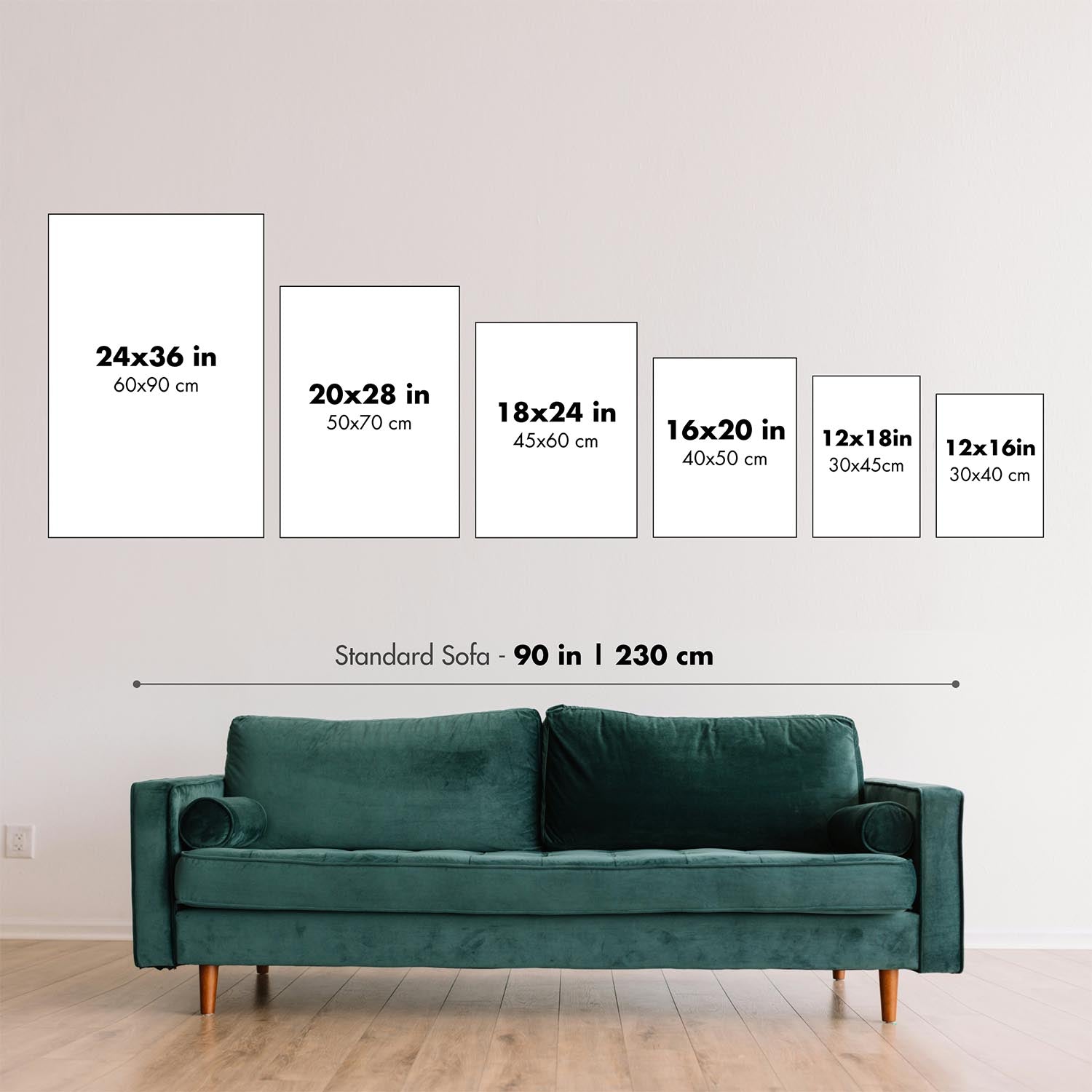
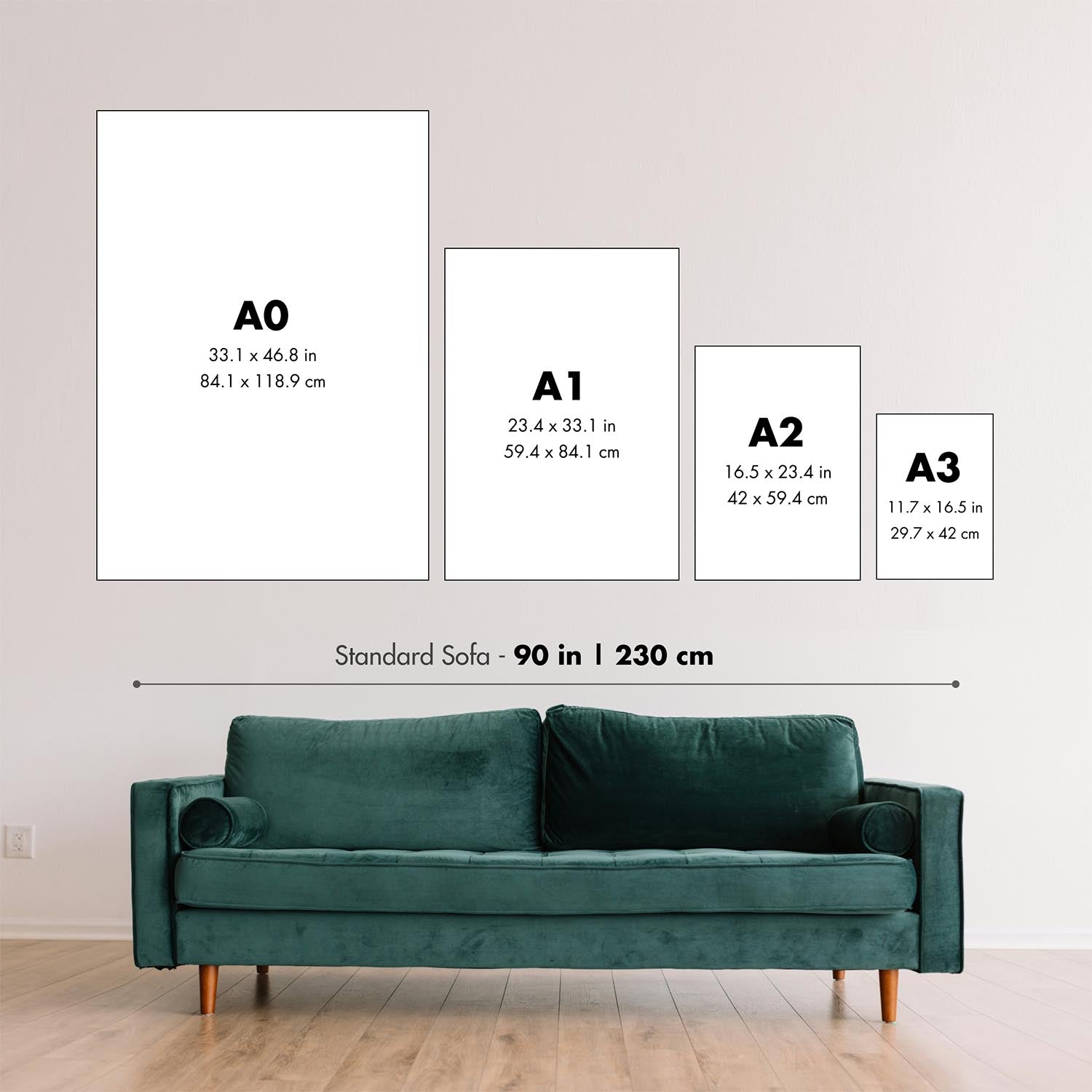
Old Map of County Carlow by Samuel Lewis, 1844: Tullow, Hacketstown, Leighlinbridge, Rathvilly, Myshall


-
![]() Handmade in Australia
Handmade in Australia
-
FREE worldwide delivery in 2-3 days ⓘ
Free delivery in 2-3 days
Your map should be delivered in 2-3 working days with free delivery, worldwide.
We make maps by hand locally in 23 countries, including Australia
![]() . If you're buying a gift for someone in another country, we will make the map locally to them.
. If you're buying a gift for someone in another country, we will make the map locally to them.You will never pay import tax or customs duty.
Express delivery is available at checkout which can reduce the delivery time to 1-2 days.
Please note that personalised maps, and larger framed maps, can take longer to produce and deliver.
If you need your order to arrive by a certain date, contact me and we can discuss your options.
-
90 day money back guarantee ⓘ
90 days to return and refund
Products can be returned within 90 days for a full refund, or exchange for another product.
For personalised or custom made items, we may offer you a non-expiring gift card, as we cannot resell personalised orders.
If you have any questions, get in touch. For more information, see our full returns & exchanges policy.

My maps are rare, museum-grade, restored old maps sourced from libraries, auction houses and private collections across the globe.
Framing & free personalisation available
This service is currently unavailable,
sorry for the inconvenience.
Pair it with a frame
Frame options are for visualization purposes only.
FRAME STYLE
MATTING SIZE
BUILDING YOUR EXPERIENCE
powered by Blankwall
Take a few steps back and let your camera see more of the scene.
powered by Blankwall
Was this experience helpful?
The Old Map of Carlow by Samuel Lewis, dated 1844, is a captivating piece that offers a glimpse into the historical landscape of County Carlow, Ireland. This meticulously crafted map showcases the region's intricate details, presenting a fascinating perspective of the area during the mid-19th century. As an esteemed collector's item, this map holds immense historical value and serves as a remarkable decorative piece for enthusiasts of cartography and Irish heritage.
While exploring this map, one must bear in mind that some modern cities may not be present, or they may appear under earlier names, adding an element of excitement and discovery. The Old Map of Carlow provides a unique opportunity to witness the evolution of settlements and landmarks over time, offering an enriching experience for history enthusiasts and those with a deep connection to the region.
Notable Settlements and Founding Dates
- Carlow (c. 600 CE): The county town of County Carlow, known for its rich history and architectural heritage.
- Tullow (c. 400 CE): A vibrant market town with a long-standing history, surrounded by beautiful countryside.
- Hacketstown (c. 1600 CE): A picturesque village nestled in the foothills of the Wicklow Mountains, renowned for its scenic charm.
- Leighlinbridge (c. 1180 CE): Home to the historic Leighlinbridge Castle, this village offers a delightful blend of history and natural beauty.
- Rathvilly (c. 1600 CE): A charming village known for its tranquil atmosphere and the impressive Rathvilly Castle.
- Myshall (c. 1600 CE): A small village with a rich agricultural heritage, situated amidst the stunning landscapes of the Blackstairs Mountains.
The list continues with the following notable settlements founded before 1840:
- Bagenalstown (c. 1660 CE): A picturesque town with a fascinating industrial past, located on the River Barrow.
- Fenagh (c. 1600 CE): A quaint village renowned for its historical sites, including the ruins of Fenagh Abbey.
- Clonegal (c. 1600 CE): A charming village with a strong sense of community, surrounded by lush greenery.
- Rathoe (c. 1600 CE): A peaceful village steeped in history, boasting the impressive Rathoe Castle.
- Ballon (c. 1600 CE): A picturesque village nestled amid rolling hills, offering a tranquil retreat.
- Kildavin (c. 1600 CE): A small village known for its idyllic setting and the ancient Kildavin Cross.
- Fennagh (c. 1600 CE): A serene village renowned for its beautiful landscapes and Fennagh House.
- Rathanna (c. 1600 CE): A quaint village with a close-knit community, surrounded by scenic countryside.
- Nurney (c. 1600 CE): A charming village with a rich agricultural heritage, located near the River Griese.
- Ardattin (c. 1600 CE): A peaceful village known for its picturesque surroundings and Ardattin Church.
- St. Mullins (c. 600 CE): A historic village situated on the banks of the River Barrow, home to St. Mullins Monastic Site.
- Killeshin (c. 600 CE): A village steeped in history, boasting the impressive Killeshin Church and Round Tower.
- Fenagh (c. 600 CE): A village with ancient roots, featuring the ruins of Fenagh Abbey and a rich Celtic heritage.
- Kernanstown (c. 600 CE): A small village with a strong sense of community, surrounded by scenic landscapes.
- Borris (c. 1600 CE): A picturesque village renowned for its stunning Borris House and beautiful countryside.
- Rathvilly (c. 600 CE): A village with a long history, home to the impressive Rathvilly Castle and Rathvilly Church.
- Aghade (c. 600 CE): A tranquil village known for its scenic beauty and the ancient Aghade Holed Stone.
- Clonmore (c. 600 CE): A village steeped in history, featuring the ruins of Clonmore Castle and Clonmore Church.
- Old Leighlin (c. 600 CE): A village with a rich ecclesiastical heritage, housing the historic Old Leighlin Cathedral.
- Ballymurphy (c. 600 CE): A charming village nestled in the countryside, offering a peaceful retreat.
- Rathanna (c. 600 CE): A quaint village known for its close-knit community and scenic surroundings.
- Fennagh (c. 600 CE): A serene village renowned for its beautiful landscapes and Fennagh House.
- Nurney (c. 600 CE): A charming village with a rich agricultural heritage, located near the River Griese.
- Ardattin (c. 600 CE): A peaceful village known for its picturesque surroundings and Ardattin Church.
Notable Natural Features and Historical Events
Notable natural features, boundaries, and historical events in County Carlow between 1800 and 1850 include:
- River Barrow: A majestic river that flows through the county, offering scenic beauty and recreational activities.
- Blackstairs Mountains: A stunning mountain range located in the southeastern part of the county, providing breathtaking views and outdoor exploration opportunities.
- Carlow Castle: A historic landmark in Carlow town, serving as a reminder of the region's medieval past.
- 1798 Rebellion: A significant event in Irish history, with County Carlow playing a role in the rebellion against British rule.
- Carlow Cathedral: A magnificent cathedral in Carlow town, showcasing impressive architecture and religious significance.
Immerse yourself in the rich history and captivating beauty of County Carlow with the Old Map of Carlow by Samuel Lewis, 1844. This extraordinary map allows you to trace the footsteps of the past, exploring the settlements, landmarks, and natural wonders that have shaped this remarkable region.
Please double check the images to make sure that a specific town or place is shown on this map. You can also get in touch and ask us to check the map for you.
This map looks great at all sizes: 12x16in (30.5x41cm), 16x20in (40.5x51cm), 18x24in (45.5x61cm), 24x30in (61x76cm), 32x40in (81.5x102cm) and 40x50in (102x127cm), but it looks even better when printed large.
I can create beautiful, large prints of this map up to 50in (127cm). Please get in touch if you're looking for larger, customised or different framing options.
The model in the listing images is holding the 16x20in (40.5x51cm) version of this map.
The fifth listing image shows an example of my map personalisation service.
Please note the unframed 24x30in (61x76cm) map has white edges around the map. These edges can help you with framing, or if you don’t need them they are very easy to snip off with scissors. All other maps, including the framed maps, look exactly like the listing images.
If you’re looking for something slightly different, check out my main collection of UK and Ireland maps.
Please contact me to check if a certain location, landmark or feature is shown on this map.
This would make a wonderful birthday, Christmas, Father's Day, work leaving, anniversary or housewarming gift for someone from the areas covered by this map.
This map is available as a giclée print on acid free archival matte paper, or you can buy it framed. The frame is a nice, simple black frame that suits most aesthetics. Please get in touch if you'd like a different frame colour or material. My frames are glazed with super-clear museum-grade acrylic (perspex/acrylite), which is significantly less reflective than glass, safer, and will always arrive in perfect condition.
1. Select your size
➢ Pick the closest size (above)
➢ Provide the exact size in millimetres
➢ Add to bag and checkout as normal
Click here to order a custom size.
2. Customise your map
Personalise your map with framing, hand-drawn customisation, vintage ageing, pop art text, unique 3D styling and moreGift message & custom finish

If you want to add a gift message, or a finish (jigsaw, aluminium board, etc.) that is not available here, please request it in the "order note" when you check out.
Every order is custom made, so if you need the size adjusted slightly, or printed on an unusual material, just let us know. We've done thousands of custom orders over the years, so there's (almost) nothing we can't manage.
You can also contact us before you order, if you prefer!

- Handmade locally. No import duty or tax
- FREE Delivery. Arrives in 2-3 days
- Love it or your money back
- Questions? WhatsApp me any time
Own a piece of history
5,000+ 5 star reviews


The Old Map of Carlow by Samuel Lewis, dated 1844, is a captivating piece that offers a glimpse into the historical landscape of County Carlow, Ireland. This meticulously crafted map showcases the region's intricate details, presenting a fascinating perspective of the area during the mid-19th century. As an esteemed collector's item, this map holds immense historical value and serves as a remarkable decorative piece for enthusiasts of cartography and Irish heritage.
While exploring this map, one must bear in mind that some modern cities may not be present, or they may appear under earlier names, adding an element of excitement and discovery. The Old Map of Carlow provides a unique opportunity to witness the evolution of settlements and landmarks over time, offering an enriching experience for history enthusiasts and those with a deep connection to the region.
Notable Settlements and Founding Dates
- Carlow (c. 600 CE): The county town of County Carlow, known for its rich history and architectural heritage.
- Tullow (c. 400 CE): A vibrant market town with a long-standing history, surrounded by beautiful countryside.
- Hacketstown (c. 1600 CE): A picturesque village nestled in the foothills of the Wicklow Mountains, renowned for its scenic charm.
- Leighlinbridge (c. 1180 CE): Home to the historic Leighlinbridge Castle, this village offers a delightful blend of history and natural beauty.
- Rathvilly (c. 1600 CE): A charming village known for its tranquil atmosphere and the impressive Rathvilly Castle.
- Myshall (c. 1600 CE): A small village with a rich agricultural heritage, situated amidst the stunning landscapes of the Blackstairs Mountains.
The list continues with the following notable settlements founded before 1840:
- Bagenalstown (c. 1660 CE): A picturesque town with a fascinating industrial past, located on the River Barrow.
- Fenagh (c. 1600 CE): A quaint village renowned for its historical sites, including the ruins of Fenagh Abbey.
- Clonegal (c. 1600 CE): A charming village with a strong sense of community, surrounded by lush greenery.
- Rathoe (c. 1600 CE): A peaceful village steeped in history, boasting the impressive Rathoe Castle.
- Ballon (c. 1600 CE): A picturesque village nestled amid rolling hills, offering a tranquil retreat.
- Kildavin (c. 1600 CE): A small village known for its idyllic setting and the ancient Kildavin Cross.
- Fennagh (c. 1600 CE): A serene village renowned for its beautiful landscapes and Fennagh House.
- Rathanna (c. 1600 CE): A quaint village with a close-knit community, surrounded by scenic countryside.
- Nurney (c. 1600 CE): A charming village with a rich agricultural heritage, located near the River Griese.
- Ardattin (c. 1600 CE): A peaceful village known for its picturesque surroundings and Ardattin Church.
- St. Mullins (c. 600 CE): A historic village situated on the banks of the River Barrow, home to St. Mullins Monastic Site.
- Killeshin (c. 600 CE): A village steeped in history, boasting the impressive Killeshin Church and Round Tower.
- Fenagh (c. 600 CE): A village with ancient roots, featuring the ruins of Fenagh Abbey and a rich Celtic heritage.
- Kernanstown (c. 600 CE): A small village with a strong sense of community, surrounded by scenic landscapes.
- Borris (c. 1600 CE): A picturesque village renowned for its stunning Borris House and beautiful countryside.
- Rathvilly (c. 600 CE): A village with a long history, home to the impressive Rathvilly Castle and Rathvilly Church.
- Aghade (c. 600 CE): A tranquil village known for its scenic beauty and the ancient Aghade Holed Stone.
- Clonmore (c. 600 CE): A village steeped in history, featuring the ruins of Clonmore Castle and Clonmore Church.
- Old Leighlin (c. 600 CE): A village with a rich ecclesiastical heritage, housing the historic Old Leighlin Cathedral.
- Ballymurphy (c. 600 CE): A charming village nestled in the countryside, offering a peaceful retreat.
- Rathanna (c. 600 CE): A quaint village known for its close-knit community and scenic surroundings.
- Fennagh (c. 600 CE): A serene village renowned for its beautiful landscapes and Fennagh House.
- Nurney (c. 600 CE): A charming village with a rich agricultural heritage, located near the River Griese.
- Ardattin (c. 600 CE): A peaceful village known for its picturesque surroundings and Ardattin Church.
Notable Natural Features and Historical Events
Notable natural features, boundaries, and historical events in County Carlow between 1800 and 1850 include:
- River Barrow: A majestic river that flows through the county, offering scenic beauty and recreational activities.
- Blackstairs Mountains: A stunning mountain range located in the southeastern part of the county, providing breathtaking views and outdoor exploration opportunities.
- Carlow Castle: A historic landmark in Carlow town, serving as a reminder of the region's medieval past.
- 1798 Rebellion: A significant event in Irish history, with County Carlow playing a role in the rebellion against British rule.
- Carlow Cathedral: A magnificent cathedral in Carlow town, showcasing impressive architecture and religious significance.
Immerse yourself in the rich history and captivating beauty of County Carlow with the Old Map of Carlow by Samuel Lewis, 1844. This extraordinary map allows you to trace the footsteps of the past, exploring the settlements, landmarks, and natural wonders that have shaped this remarkable region.
Please double check the images to make sure that a specific town or place is shown on this map. You can also get in touch and ask us to check the map for you.
This map looks great at all sizes: 12x16in (30.5x41cm), 16x20in (40.5x51cm), 18x24in (45.5x61cm), 24x30in (61x76cm), 32x40in (81.5x102cm) and 40x50in (102x127cm), but it looks even better when printed large.
I can create beautiful, large prints of this map up to 50in (127cm). Please get in touch if you're looking for larger, customised or different framing options.
The model in the listing images is holding the 16x20in (40.5x51cm) version of this map.
The fifth listing image shows an example of my map personalisation service.
Please note the unframed 24x30in (61x76cm) map has white edges around the map. These edges can help you with framing, or if you don’t need them they are very easy to snip off with scissors. All other maps, including the framed maps, look exactly like the listing images.
If you’re looking for something slightly different, check out my main collection of UK and Ireland maps.
Please contact me to check if a certain location, landmark or feature is shown on this map.
This would make a wonderful birthday, Christmas, Father's Day, work leaving, anniversary or housewarming gift for someone from the areas covered by this map.
This map is available as a giclée print on acid free archival matte paper, or you can buy it framed. The frame is a nice, simple black frame that suits most aesthetics. Please get in touch if you'd like a different frame colour or material. My frames are glazed with super-clear museum-grade acrylic (perspex/acrylite), which is significantly less reflective than glass, safer, and will always arrive in perfect condition.
This map is also available as a float framed canvas, sometimes known as a shadow gap framed canvas or canvas floater. The map is printed on artist's cotton canvas and then stretched over a handmade box frame. We then "float" the canvas inside a wooden frame, which is available in a range of colours (black, dark brown, oak, antique gold and white). This is a wonderful way to present a map without glazing in front. See some examples of float framed canvas maps and explore the differences between my different finishes.
For something truly unique, this map is also available in "Unique 3D", our trademarked process that dramatically transforms the map so that it has a wonderful sense of depth. We combine the original map with detailed topography and elevation data, so that mountains and the terrain really "pop". For more info and examples of 3D maps, check my Unique 3D page.
For most orders, delivery time is about 3 working days. Personalised and customised products take longer, as I have to do the personalisation and send it to you for approval, which usually takes 1 or 2 days.
Please note that very large framed orders usually take longer to make and deliver.
If you need your order to arrive by a certain date, please contact me before you order so that we can find the best way of making sure you get your order in time.
I print and frame maps and artwork in 23 countries around the world. This means your order will be made locally, which cuts down on delivery time and ensures that it won't be damaged during delivery. You'll never pay customs or import duty, and we'll put less CO2 into the air.
All of my maps and art prints are well packaged and sent in a rugged tube if unframed, or surrounded by foam if framed.
I try to send out all orders within 1 or 2 days of receiving your order, though some products (like face masks, mugs and tote bags) can take longer to make.
If you select Express Delivery at checkout your order we will prioritise your order and send it out by 1-day courier (Fedex, DHL, UPS, Parcelforce).
Next Day delivery is also available in some countries (US, UK, Singapore, UAE) but please try to order early in the day so that we can get it sent out on time.
My standard frame is a gallery style black ash hardwood frame. It is simple and quite modern looking. My standard frame is around 20mm (0.8in) wide.
I use super-clear acrylic (perspex/acrylite) for the frame glass. It's lighter and safer than glass - and it looks better, as the reflectivity is lower.
Six standard frame colours are available for free (black, dark brown, dark grey, oak, white and antique gold). Custom framing and mounting/matting is available if you're looking for something else.
Most maps, art and illustrations are also available as a framed canvas. We use matte (not shiny) cotton canvas, stretch it over a sustainably sourced box wood frame, and then 'float' the piece within a wood frame. The end result is quite beautiful, and there's no glazing to get in the way.
All frames are provided "ready to hang", with either a string or brackets on the back. Very large frames will have heavy duty hanging plates and/or a mounting baton. If you have any questions, please get in touch.
See some examples of my framed maps and framed canvas maps.
Alternatively, I can also supply old maps and artwork on canvas, foam board, cotton rag and other materials.
If you want to frame your map or artwork yourself, please read my size guide first.
My maps are extremely high quality reproductions of original maps.
I source original, rare maps from libraries, auction houses and private collections around the world, restore them at my London workshop, and then use specialist giclée inks and printers to create beautiful maps that look even better than the original.
My maps are printed on acid-free archival matte (not glossy) paper that feels very high quality and almost like card. In technical terms the paper weight/thickness is 10mil/200gsm. It's perfect for framing.
I print with Epson ultrachrome giclée UV fade resistant pigment inks - some of the best inks you can find.
I can also make maps on canvas, cotton rag and other exotic materials.
Learn more about The Unique Maps Co.
Map personalisation
If you're looking for the perfect anniversary or housewarming gift, I can personalise your map to make it truly unique. For example, I can add a short message, or highlight an important location, or add your family's coat of arms.
The options are almost infinite. Please see my map personalisation page for some wonderful examples of what's possible.
To order a personalised map, select "personalise your map" before adding it to your basket.
Get in touch if you're looking for more complex customisations and personalisations.
Map ageing
I have been asked hundreds of times over the years by customers if they could buy a map that looks even older.
Well, now you can, by selecting Aged before you add a map to your basket.
All the product photos you see on this page show the map in its Original form. This is what the map looks like today.
If you select Aged, I will age your map by hand, using a special and unique process developed through years of studying old maps, talking to researchers to understand the chemistry of aging paper, and of course... lots of practice!
If you're unsure, stick to the Original colour of the map. If you want something a bit darker and older looking, go for Aged.
If you are not happy with your order for any reason, contact me for a no-quibble refund.
I am very confident you will like your restored map or art print. I have been doing this since 1984. I'm a 5-star Etsy seller. I have sold tens of thousands of maps and art prints and have over 4,000 real 5-star reviews.
I use a unique process to restore maps and artwork that is massively time consuming and labour intensive. Hunting down the original maps and illustrations can take months. I use state of the art and eye-wateringly expensive technology to scan and restore them. As a result, I guarantee my maps and art prints are a cut above the rest - that's why I can offer a no-quibble refund.
Almost all of my maps and art prints look amazing at large sizes (200cm, 6.5ft+) and I can frame and deliver them to you as well, via special oversized courier. Contact me to discuss your specific needs.
Or try searching for something!





